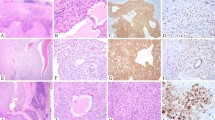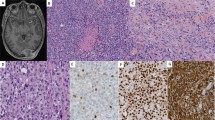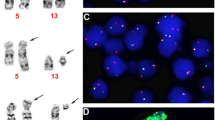Abstract
Ewing tumours (ET), including Ewing's sarcoma and peripheral primitive neuroectodermal tumour, are well characterised at the molecular level by a unique chromosomal rearrangement which fuses the EWS gene to one of two closely related ETS proto-oncogenes, FLI-1 or ERG. Expression of the resulting chimaeric transcripts can be readily detected by reversed transcriptase polymerase chain reaction (RT-PCR). This approach led to the identification of a number of different exon combinations at the junction site of coding sequences. The physiological consequences of the observed variability in the hinge region of EWS chimaeric proteins are not known. We have analysed tumour-derived material from 30 ET patients with well-documented clinical course (18 with localised and 12 with metastatic disease at diagnosis) for the presence of EWS/FLI-1 or EWS/ERG RNA. Karyotypes were obtained in 21 out of 27 cases and analysed by routine cytogenetics. A chromosome 22 rearrangement was demonstrated in 18 cases (67%). In contrast, RT-PCR revealed the presence of chimaeric transcripts in 28 tumours (93%), with fusions of EWS exon 7 to FLI-1 exons 6 (19/28), 5 (4/28) and 7 (1/28). In addition, EWS/FLI-1 exon combinations 10/5 and 9/4 were observed in one case each. In the last tumour, the presence of at least four additional splicing variants corresponding to fusion of EWS exon 7 to FLI-1 exons 4, 6, 8 and 9 was demonstrated. Two tumours expressed EWS/ERG fusion transcripts involving EWS exon 7 and ERG exon 6. In this study, EWS/FLI-1 exon combinations 7/6 (type I) predominated over 7/5 (type II) in localised ET (14 versus 1) and were more abundant in tumours affecting the long bones (9 versus 0), whereas in central axis tumours and metastatic disease there was only little difference in the frequency of the two types. So far, no correlations between different chimaeric EWS transcripts and any other clinical parameters have been identified.
This is a preview of subscription content, access via your institution
Access options
Subscribe to this journal
Receive 24 print issues and online access
$259.00 per year
only $10.79 per issue
Buy this article
- Purchase on Springer Link
- Instant access to full article PDF
Prices may be subject to local taxes which are calculated during checkout
Similar content being viewed by others
Author information
Authors and Affiliations
Rights and permissions
About this article
Cite this article
Zoubek, A., Pfleiderer, C., Salzer-Kuntschik, M. et al. Variability of EWS chimaeric transcripts in Ewing tumours: a comparison of clinical and molecular data. Br J Cancer 70, 908–913 (1994). https://doi.org/10.1038/bjc.1994.419
Issue Date:
DOI: https://doi.org/10.1038/bjc.1994.419
This article is cited by
-
Molecular detection and targeting of EWSR1 fusion transcripts in soft tissue tumors
Medical Oncology (2013)
-
Multiple splice variants of EWSR1-ETS fusion transcripts co-existing in the Ewing sarcoma family of tumors
Cellular Oncology (2013)
-
Expression of ERG, an Ets family transcription factor, identifies ERG-rearranged Ewing sarcoma
Modern Pathology (2012)
-
Ewing Sarcoma tumor cells express CD34: implications for autologous stem cell transplantation
Bone Marrow Transplantation (2007)
-
Prognostic impact of chromosomal aberrations in Ewing tumours
British Journal of Cancer (2002)



